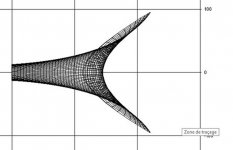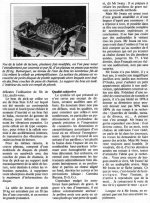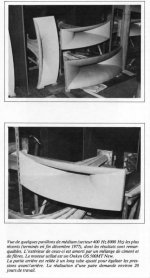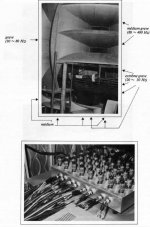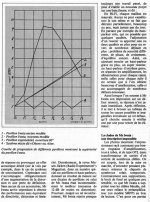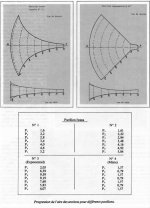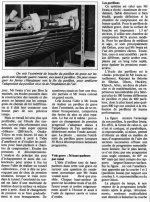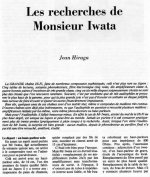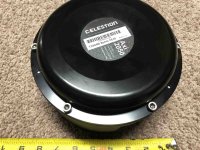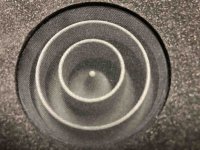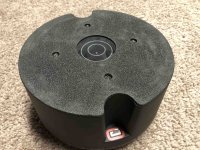The construction is amazing. The way it looks as though the HF horn was carved into the same single piece of wood as the mid.Like this?
Maybe he could use the version with roll-back but with projection. The projection itself reduces the mouth diffraction effects.
Here two versions with increasing T and different stereographic projection applied and slightly lower cur-off:
View attachment 795647 View attachment 795648
View attachment 795649
View attachment 795650
Btw, with progressive expansion T the cut-off value has less meaning but it still determines the construction vector.
Any version if you cross @ 650?
JMLC horns with the spiral (270°) rollback are different from the IWATA and E-JMLC.
Originally, the JMLC Quasi IWATA horns have a 180° "opening" (rollback).
All (commercially) produced IWATA JMLC horns have a truncated mouth in order to reduce the height.
Originally, the JMLC Quasi IWATA horns have a 180° "opening" (rollback).
All (commercially) produced IWATA JMLC horns have a truncated mouth in order to reduce the height.
Attachments
Any version if you cross @ 650?
For a calculator it is no problem to make any size but in reality 😀
This should load in the range you asked for. fo a more detailed version you need to provide throat diameter and stretch ratio.
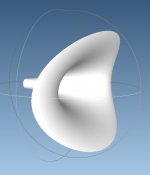
View attachment drba_SWH230_EP_SF138__PET-07-07-14.zip
drba_Jericho_45_PE - Simulation
This horn has a very sharp edge at the mouth that is causing diffraction and reflections. It may go low enough but I think the mouth termination needs improvement.
This horn has a very sharp edge at the mouth that is causing diffraction and reflections. It may go low enough but I think the mouth termination needs improvement.
Attachments
-
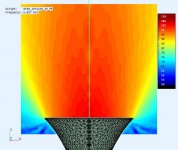 drba_Jericho_45_PE-Hfield@6KHz.jpg40.7 KB · Views: 66
drba_Jericho_45_PE-Hfield@6KHz.jpg40.7 KB · Views: 66 -
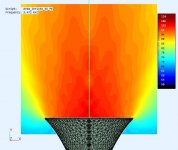 drba_Jericho_45_PE-Hfield@3K5Hz.jpg39.5 KB · Views: 66
drba_Jericho_45_PE-Hfield@3K5Hz.jpg39.5 KB · Views: 66 -
 drba_Jericho_45_PE-Hfield@1K5Hz.jpg39 KB · Views: 68
drba_Jericho_45_PE-Hfield@1K5Hz.jpg39 KB · Views: 68 -
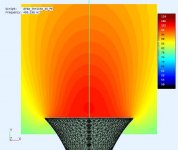 drba_Jericho_45_PE-Hfield@500Hz.jpg37.7 KB · Views: 70
drba_Jericho_45_PE-Hfield@500Hz.jpg37.7 KB · Views: 70 -
 drba_Jericho_45_PE-Hfield@200Hz.jpg35.1 KB · Views: 81
drba_Jericho_45_PE-Hfield@200Hz.jpg35.1 KB · Views: 81 -
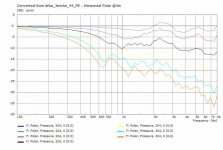 drba_Jericho_45_PE-HorzPolarCurves@3m.jpg48.4 KB · Views: 91
drba_Jericho_45_PE-HorzPolarCurves@3m.jpg48.4 KB · Views: 91 -
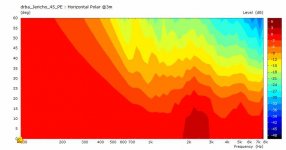 drba_Jericho_45_PE-HorzPolarCont@3m.jpg25.4 KB · Views: 348
drba_Jericho_45_PE-HorzPolarCont@3m.jpg25.4 KB · Views: 348 -
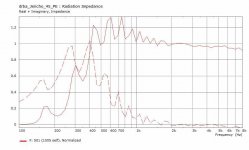 drba_Jericho_45_PE-RadImp.jpg38 KB · Views: 344
drba_Jericho_45_PE-RadImp.jpg38 KB · Views: 344 -
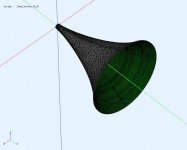 drba_jericho_45_PE-3Dview.jpg56.4 KB · Views: 338
drba_jericho_45_PE-3Dview.jpg56.4 KB · Views: 338
drba_Shark_RA_45_PE_PRJ - Simulation Results
Similar issues with the mouth termination.
Similar issues with the mouth termination.
Attachments
-
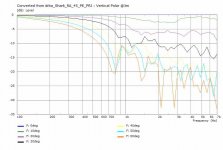 drba_Shark_RA_45_PE_PRJ-VertPolarCurve@3m.jpg43.3 KB · Views: 69
drba_Shark_RA_45_PE_PRJ-VertPolarCurve@3m.jpg43.3 KB · Views: 69 -
 drba_Shark_RA_45_PE_PRJ-VertPolarCont@3m.jpg24.6 KB · Views: 67
drba_Shark_RA_45_PE_PRJ-VertPolarCont@3m.jpg24.6 KB · Views: 67 -
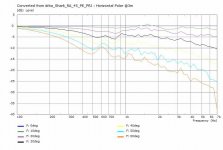 drba_Shark_RA_45_PE_PRJ-HorzPolarCurve@3m.jpg42.3 KB · Views: 74
drba_Shark_RA_45_PE_PRJ-HorzPolarCurve@3m.jpg42.3 KB · Views: 74 -
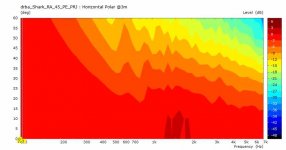 drba_Shark_RA_45_PE_PRJ-HorzPolarCont@3m.jpg25.1 KB · Views: 84
drba_Shark_RA_45_PE_PRJ-HorzPolarCont@3m.jpg25.1 KB · Views: 84 -
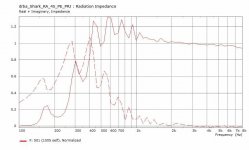 drba_Shark_RA_45_PE_PRJ-RadImp.jpg38.4 KB · Views: 87
drba_Shark_RA_45_PE_PRJ-RadImp.jpg38.4 KB · Views: 87 -
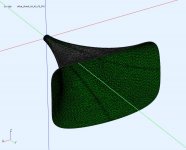 drba_Shark_RA_45_PE_PRJ-3Dview.jpg80.5 KB · Views: 79
drba_Shark_RA_45_PE_PRJ-3Dview.jpg80.5 KB · Views: 79
drba_Shark_RA_45_PE_PRJ - Simulation Results
.. and the observation fields
.. and the observation fields
Attachments
-
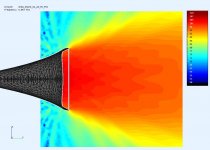 drba_Shark_RA_45_PE_PRJ-Vfield@6KHz.jpg57.8 KB · Views: 81
drba_Shark_RA_45_PE_PRJ-Vfield@6KHz.jpg57.8 KB · Views: 81 -
 drba_Shark_RA_45_PE_PRJ-Vfield@3K5Hz.jpg54.3 KB · Views: 78
drba_Shark_RA_45_PE_PRJ-Vfield@3K5Hz.jpg54.3 KB · Views: 78 -
 drba_Shark_RA_45_PE_PRJ-Vfield@1K5Hz.jpg52.6 KB · Views: 73
drba_Shark_RA_45_PE_PRJ-Vfield@1K5Hz.jpg52.6 KB · Views: 73 -
 drba_Shark_RA_45_PE_PRJ-Vfield@500Hz.jpg50.7 KB · Views: 67
drba_Shark_RA_45_PE_PRJ-Vfield@500Hz.jpg50.7 KB · Views: 67 -
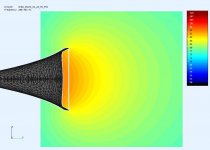 drba_Shark_RA_45_PE_PRJ-Vfield@200Hz.jpg48.3 KB · Views: 67
drba_Shark_RA_45_PE_PRJ-Vfield@200Hz.jpg48.3 KB · Views: 67 -
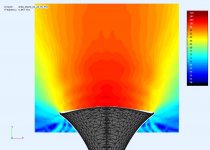 drba_Shark_RA_45_PE_PRJ-Hfield@6KHz.jpg58.5 KB · Views: 58
drba_Shark_RA_45_PE_PRJ-Hfield@6KHz.jpg58.5 KB · Views: 58 -
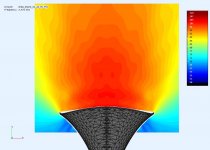 drba_Shark_RA_45_PE_PRJ-Hfield@3K5Hz.jpg56.2 KB · Views: 64
drba_Shark_RA_45_PE_PRJ-Hfield@3K5Hz.jpg56.2 KB · Views: 64 -
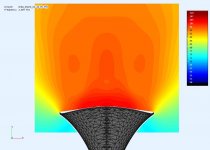 drba_Shark_RA_45_PE_PRJ-Hfield@1K5Hz.jpg53.6 KB · Views: 63
drba_Shark_RA_45_PE_PRJ-Hfield@1K5Hz.jpg53.6 KB · Views: 63 -
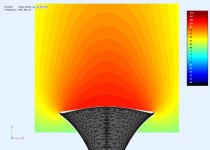 drba_Shark_RA_45_PE_PRJ-Hfield@500Hz.jpg53.1 KB · Views: 69
drba_Shark_RA_45_PE_PRJ-Hfield@500Hz.jpg53.1 KB · Views: 69 -
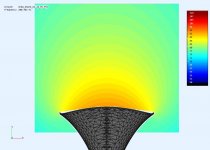 drba_Shark_RA_45_PE_PRJ-Hfield@200Hz.jpg50.7 KB · Views: 68
drba_Shark_RA_45_PE_PRJ-Hfield@200Hz.jpg50.7 KB · Views: 68
Don, do you agree the ripples seem to flatten once the wavelengths are smaller than the mouth circumference, >1k?
Once again, thank you for the efforts!
Once again, thank you for the efforts!
Last edited:
Yes, but the horn is starting to beam at that point. I think adding a small round over would help this issue. I've seen that improve lots of simulation results.
No problem to run a few sims. I'm interested in how this progresses.
Added - are you suggesting the mouth is too small to support the lower freq?
No problem to run a few sims. I'm interested in how this progresses.
Added - are you suggesting the mouth is too small to support the lower freq?
Last edited:
All these truncated horns are a compromise. For the last two just simulated the parameters were maybe pushed too hard to get a larger mouth.
If I would be into business I would say that camplo is a challenging customer with a very special taste 😉
The horn he is searching for might be already in the range of WE12a/WE13a.
I am not sure how the power stage is intended, but he would need a digital delay for time aligning the drivers if the horn is so long.
If I would be into business I would say that camplo is a challenging customer with a very special taste 😉
The horn he is searching for might be already in the range of WE12a/WE13a.
I am not sure how the power stage is intended, but he would need a digital delay for time aligning the drivers if the horn is so long.
he would need a digital delay for time aligning the drivers if the horn is so long.
Or adopt an "elegant solution" 😀
The mouth round-overs are interesting. FWIW, the original Iwata horns - the ones he used at home - had a unique termination. The edges were slotted. Ro808 will know what I mean.
At the mouth edge Mr Iwata broke up the surface into slats with progressively wider gaps as the curve moved out. It was meant to allow a progressive transition from hard surface to soft termination. Or perhaps from high impedance to low impedance. The idea came from his work on reducing shock wave at the mouths of the high speed train tunnels.
At the mouth edge Mr Iwata broke up the surface into slats with progressively wider gaps as the curve moved out. It was meant to allow a progressive transition from hard surface to soft termination. Or perhaps from high impedance to low impedance. The idea came from his work on reducing shock wave at the mouths of the high speed train tunnels.
Ok, just the hot results from the Sim for the 45 deg termination mouth horn:
The LF performance show some ripples but this seems to be normal for such a type. It should load very low. The oberservation spectrum views are not as nice as for the roll-back horns but this horn is a compromise. I expected even more artifacts because of the sudden mouth termination.
View attachment 795327 View attachment 795328 View attachment 795329 View attachment 795330
View attachment 795331 View attachment 795332 View attachment 795333
View attachment 795334
View attachment 795335
So this horn is the only one that can support 200 so far? I guess you wouldn’t need max output at 200hz if it’s being crossed since it would be down because of the xover... I asked before exactly what are pictures depicting outside of directivity, I’m pretty sure the colors represent levels of transfer function vs distance and position, for example the red area in the 200hz suggest that if you are past a certain distance that range will start to fall off.
Last edited:
The mouth round-overs are interesting. FWIW, the original Iwata horns - the ones he used at home - had a unique termination. The edges were slotted. Ro808 will know what I mean.
At the mouth edge Mr Iwata broke up the surface into slats with progressively wider gaps as the curve moved out. It was meant to allow a progressive transition from hard surface to soft termination. Or perhaps from high impedance to low impedance. The idea came from his work on reducing shock wave at the mouths of the high speed train tunnels.
That's a coincidence, because I was just looking into Onken SC500 and Le Dauphin, which are sectoral horns. The Onken was also used by mr. Sato at the time of Jean Hiraga's visit.
And yes, Mr. Iwata used vaines for his (sub)horns, as described and pictured in the attached article from the French magazine l'Audiophile. The original long midhorns are also shown.
The Japanese masters improved upon many of the classic horns by applying sophisticated damping methods.
Attachments
Last edited:
The mouth round-overs are interesting. FWIW, the original Iwata horns - the ones he used at home - had a unique termination. The edges were slotted. Ro808 will know what I mean.
I'll give you this, I'll bet that would actually work.
According to this article it was, but I wouldn't be surprised if he (later) used slots for other horns as well.
Speaking of horns... For those living in Canada and perhaps the USA, I just stumbled upon a really attractive offer for one of the best PA horns, the XT1464. It's less than 1/3 of the average retail price here in Europe.
They also sell the excellent B&C DE920TN (with Mylar surrounded diaphragm) and the Celestion CDX-1745 (far) below regular market prices.
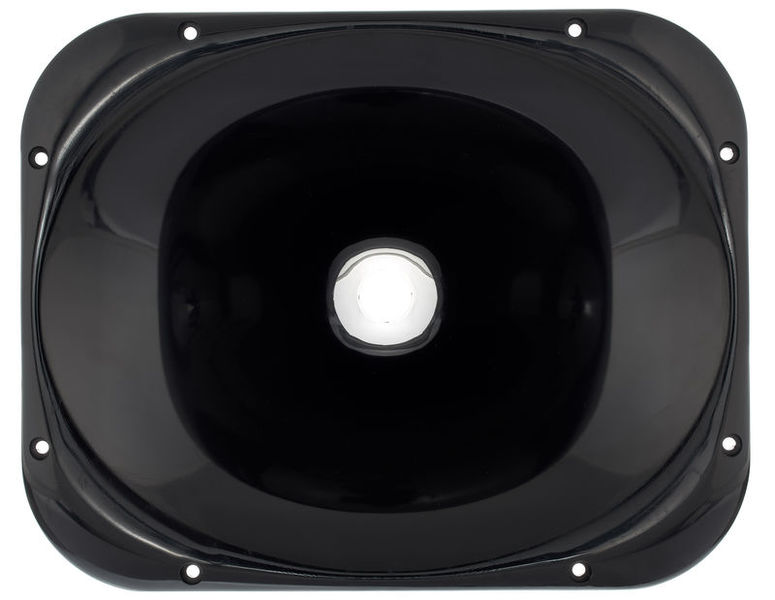
Speaking of horns... For those living in Canada and perhaps the USA, I just stumbled upon a really attractive offer for one of the best PA horns, the XT1464. It's less than 1/3 of the average retail price here in Europe.
They also sell the excellent B&C DE920TN (with Mylar surrounded diaphragm) and the Celestion CDX-1745 (far) below regular market prices.

Last edited:
Speaking of horns... For those living in Canada and perhaps the USA, I just stumbled upon a really attractive offer for one of the best PA horns, the XT1464. It's less than 1/3 of the average retail price here in Europe.
Dang! Just ordered some. Thanks for the heads up!!

Yorkville was among the first overseas OEM clients of B&C (which since 2016 also owns 18Sound/Ciare).
Recently, I watched this interview with Lorenzo Coppini, CEO of B&C Speakers SpA, in which he speaks about the history of the company, specifically the increased growth since the 1990s.
At 2:30, he refers to B&C's "gamechanger", of which I happen to own a pair.
Recently, I watched this interview with Lorenzo Coppini, CEO of B&C Speakers SpA, in which he speaks about the history of the company, specifically the increased growth since the 1990s.
At 2:30, he refers to B&C's "gamechanger", of which I happen to own a pair.
Attachments
- Home
- Loudspeakers
- Multi-Way
- Is it possible to cover the whole spectrum, high SPL, low distortion with a 2-way?

